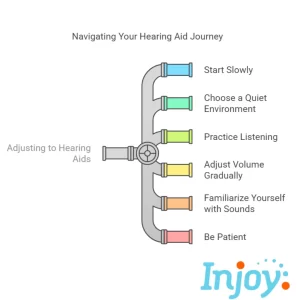
How Do I Get a Hearing Aid?
“WHAT?” You’ve said it so many times your family started a drinking game. The TV volume creeps higher. Your spouse has that look of resigned
Home » 10 Tips for Getting Used to Hearing Aids

Getting used to hearing aids can feel like a marathon, not a sprint. When you first start wearing them, sounds might seem louder, sharper, or downright strange. Your own voice could sound like it’s echoing from a cave! But why does this happen? The answer lies in the fascinating science of auditory adaptation.
When you’ve lived with hearing loss for a while, your brain deprioritizes sounds it no longer hears. This process, called auditory deprivation, essentially rewires your brain to focus on other stimuli. Hearing aids reintroduce those forgotten sounds, creating a surge of new sensory input. Initially, this can overwhelm the auditory cortex—the part of your brain that processes sound. It’s like trying to take a sip from a firehose.
Fortunately, your brain has an incredible ability to adapt, thanks to neuroplasticity. Neuroplasticity allows your brain to form new neural connections and strengthen pathways that help you process sound more effectively over time. With consistent hearing aid use, your auditory system gradually relearns how to filter background noise, prioritize speech, and interpret a wide range of sounds.
It’s important to remember that this adaptation process takes time and patience. Think of it as a workout for your brain—challenging at first but ultimately rewarding. Let’s dive into ten practical tips to help you navigate this transition with ease and maybe even a laugh or two.
Learn more about how hearing aids boost cognitive function.

Table of Contents
ToggleYour new hearing aids might make every sound feel like it’s on blast. Start at home or in quiet spaces. Practice listening to one-on-one conversations, the hum of the fridge, or even the gentle snores of your dog.
Once you’re comfortable, move to noisier environments like a café. Remember, your brain is relearning how to filter out background noise—it’s like training for an auditory decathlon. Adjusting gradually helps you avoid feeling overwhelmed.
Think of your ears as marathon runners—they need training and rest. Wear your hearing aids for a few hours at first. Gradually increase your wearing time as your ears and brain adapt.
If you’re using hearing aids for tinnitus relief, breaks require a slightly different approach. Instead of complete silence, consider soft background sounds like white noise or gentle music. These can help keep your tinnitus manageable during rest periods. Avoid removing your hearing aids for too long, as the contrast may make the ringing seem louder.
Fatigue is common in the early days, so don’t feel guilty about taking breaks. Over time, your endurance will grow, and wearing your hearing aids all day will feel natural.
Bonus: Use breaks to enjoy some peace and quiet—or soothing background sounds—before diving back into the world of amplified sound.
Your voice might sound weird at first, like you’re hearing it through a megaphone. To adjust, read aloud to yourself, talk to your plants, or narrate your favorite TV show. It’s a great way to practice without judgment—unless your dog decides otherwise.
Chewing, swallowing, and even breathing might sound louder than expected. This sensation, called the occlusion effect, fades as your brain acclimates. If it doesn’t, reach out to your hearing care provider for adjustments.
Modern hearing aids are tech marvels. Take time to learn their settings, how to adjust volume, and connect them to devices. Experiment with noise reduction and speech focus features. The more you know, the smoother your transition.
Practice inserting and removing your hearing aids, and know how to clean them properly. Regular care keeps them functioning their best and avoids unexpected hiccups.
Hearing aids do more than amplify—they help you pinpoint where sounds come from. Play a game of “What’s That Noise?” in your home. Is it the kettle boiling? A bird outside? Or your partner sneaking snacks from the kitchen?
This practice not only sharpens your listening skills but also re-trains your brain to focus on relevant sounds. Over time, distinguishing between noises becomes second nature.

Suddenly, you might hear every clink of cutlery or the rustle of paper. Your brain has to relearn which sounds to ignore. Start with quiet restaurants before tackling a bustling family reunion.
Be mindful of your settings. Many hearing aids have programs designed to reduce background noise, so experiment to find what works best. Patience is key—your brain needs time to adjust.
If you bought hearing aids through Injoy Hearing, take advantage of our virtual support options. Reach out via email or chat for guidance on fit, sound adjustments, or troubleshooting. You can also schedule an appointment with one of our service providers. We also provide video tutorials and FAQs to help you get the most from your hearing aids.
If you didn’t buy your devices through Injoy Hearing, there’s still hope! Check out your hearing aid maker’s product pages and support pages. You can also find information from hearing organizations like the Hearing Loss Association of America or Healthy Hearing.
Watching TV or movies? Turn on captions or subtitles to connect words with sounds. Bonus: It helps when characters mumble through crucial plot points.
This practice reinforces your ability to link auditory cues with language. It’s also a handy trick when adjusting to new accents or unfamiliar voices.

Ask friends and family to face you when speaking and to slow down their pace. Tell them about your hearing aids—it’s a team effort to make conversations smoother.
Encourage loved ones to minimize background noise during conversations and to repeat themselves if necessary. Open communication ensures everyone feels included.
Every small win deserves recognition. Hearing birds chirp again or understanding your grandkid’s joke is a triumph. Keep a journal of these moments to see how far you’ve come.
Acknowledge the challenges, too. Celebrating milestones, no matter how minor, helps maintain a positive outlook during the adjustment period.
Understand the emotional benefits of wearing hearing aids.
Getting used to hearing aids is a journey, not an overnight fix. Patience, practice, and humor will see you through the quirks and challenges. Don’t hesitate to contact your hearing care provider if you face difficulties—they’re there to help every step of the way.
Ready to make the most of your hearing aids? Contact Injoy Hearing today for expert advice, support, and personalized care. Let’s help you rediscover the sounds of life!

“WHAT?” You’ve said it so many times your family started a drinking game. The TV volume creeps higher. Your spouse has that look of resigned

If a noisy restaurant feels like a boss fight, you’re not alone. The real showdown is Signia Pure Charge&Go IX vs Phonak Sphere Infinio. One

If you’ve ever cranked up the TV until the dog gave you side‑eye, you’ve probably Googled cheap hearing aids. The price tags look friendly. The

If choosing a hearing aid brand feels like speed-dating for your ears, you’re not alone. Every company claims to have the clearest sound, smartest AI,
Injoy specializes in crafting custom Phonak hearing aid solutions tailored to the unique hearing needs of our patients. With a team recognized as the best in the business and decades of experience in helping people nationwide, we’re dedicated to improving your hearing and, consequently, enhancing your quality of life.
To start your journey towards better hearing with confidence, Injoy is proud to offer a 30-day risk-free hearing aid trial. This allows you to experience the difference our Phonak hearing aids can make, ensuring they meet your expectations and fit your lifestyle perfectly.
Improve your hearing and improve your life today by contacting Injoy to learn more about our risk-free trial!

Need hearing aids? Explore our range of hearing aids and discover the best option for your lifestyle and Unique Hearing Needs.
Are you a current patient with us? We're here to help with any adjustments, repairs, or support you may need.